The Zombie Wizard-Cat of Oz (Part 1 of 2)
Posted by Remya Padmadas on September 22, 2017Vinayak Varma, writes and draws things. He has written, guest edited and art directed STEM picture books for Pratham Books. Visit him at www.instagram.com/mixtape.in
Give nine people the exact same brief, and there’s a good chance that you’ll end up with nine different kinds of output. I’ve always been curious to know what happens on that journey between idea and execution, and what makes similar stories live out such different lives in the minds of different artists and writers. This is perhaps the only thing that motivates me to collaborate with others, speaking as a cranky hermit type who prefers working alone.
I write and illustrate for a living (a large part of which has lately been in aid of PB StoryWeaver). Every new project I take on is invariably a triathlon event that begins with a plunge into the Bottomless Pool of Procrastination, followed by a deathly plod across the Minefield of Migraines and a bicycle race through the No-Man’s-Land of Forgotten Deadlines. Somewhere along this crazy path, the odd conceptual tangents that inform the best parts of my work tend to sneak up on me like little ninjas. I'm usually too annoyed or preoccupied while I’m working to make note of precisely how any of it happened, and once the moment has passed and the job is done -- provided that job has any depth, truth or beauty to it -- it's easy enough to shrug and pretend like I'd been hit by some Joycean haiku moment.
But mastery of one’s art comes from understanding the mechanics of these creative accidents. If you can unpack it, you can duplicate it. However, the trouble with writing stories or making art is that they require you to exist in an isolated, meditative bubble where you're engaging deeply with the problem at hand, whereas the route to this bubble is through much distraction and muddled thinking. In order to parse the finer workings of this process, you need to be able to slip outside of your bubble at will (while maintaining an accessible distance), catch yourself in the act of being creative, and then be detached enough to pause and document what's happening. It’s a dilemma akin to that of Schrodinger’s cat -- the creative moment exists in a sort of delicate half-alive, half-dead state, where the very act of observing it risks killing it.
Of course, there are other, loftier parts to publishing, from where one can gain an interesting new vantage of some these abstract areas of book-making: hello and welcome to the Highlands, where clowders of editors scour the hillsides for errant adverbs like goats looking for tasty trash. These are cold, dry places where many authors and illustrators don’t dare venture for fear of losing their precious senses of self. Well, I do go there every so often, because I’m foolhardy like that. Here’s what I discovered up there: nothing returns your inner moggie to its quantum state like stage-managing the creation of picture books (as opposed to being one of the actors out in front). Editing and art directing let you view and gently influence the many moving parts of a project, watching creativity in action, without the blinding pressure of being the primary authorial voice. You get to observe the zombie cat but, also, you ARE the zombie cat. I recommend this exercise to all writers and illustrators at least once in their careers: not only does it let you see how other people make things, thereby enriching your own work, but it also acquaints you with the terrible power and omnipotence that commissioning editors have to live with daily. This can build empathy, if nothing else.
I got my most recent taste of this awesome power last year when I was hired to commission a set of nine STEM picture books for Pratham Books' StoryWeaver. I planned, ideated, edited and art directed four of these, which were on science. I got to art direct another four, from editor Bijal Vachharajani’s set of environment-themed stories. And I wrote and illustrated the ninth, themed on emotional intelligence, which meant that I too got to make, even as I guided and observed others in the act of making. In sum, I got to pull back the curtain and see all the wheels turn at once, to catch the decaying particle as it sped towards the poison vial, to expose the regular dude masquerading as… as…. a wizard… no, a dead cat… no, a living cat… no, a mountain goat... Look, the point is: this scarecrow has a fresh, insight-filled brain now. Chew on that, zombies.
I’m going to try and share some of that insight (or at least a bit more about the merits to following my particular path to such insight) in part 2 of this post, next week. Meanwhile, let’s look at some of the books that I just mentioned:
The Science Books
For the set of science books that I had to both edit and art direct, I was asked to come up with a few interesting themes and story ideas, and, once they'd been approved in-house, to farm them out to freelance writers and illustrators who were best suited to each idea. Four stories were then shortlisted from the seven or eight ideas that I suggested to my commissioning editors at Pratham Books (yes, even commissioning editors like me have commissioning editors, who in turn have other, bigger, older commissioning editors, who answer to still larger, greyer commissioning editors, etcetera, etcetera, all the way down, like the proverbial Jenga-stack of cosmic turtles).
I'm going to show you exactly how rudimentary these four early ideas were, so that you can gasp and grow silent with awe when you see what they ultimately became in the hands of my talented gang of writers and illustrators. Hold onto your seats.
--
"Dear Commissioning Space-Turtle #X,
Here are some ideas:
1. A kid has a cold. S/he then gives it to everyone else in his/her class via sneezes and things. Because epidemiology, boss.
2. An old lady heads out with a walking stick and her grandkid in tow. She uses her stick in various fun ways during the walk, pushing, pulling, propping up, etc., thereby demonstrating how simple machines work. Because physics and stuff, boss.
3. On birds devolving into dinosaurs, a la the chickenosaurus conjecture. Cluck, roar, repeat. Because why the hell not.
4. Crocodiles? Reptiles? Rom Whitaker? Because conservation biology, kids.
+ a few more that probably aren't worth going into given space(!)-constraints in this fake-email-within-an-already-interminable-blog-post.
Sincerely,
Commissioning Space-Turtle #Y"
--
As you can see, the whole scheme began with a pith of one-liners that bore a 50-50 potential to go either way: to turn into something halfway-decent, or utter trash. What emerged at the end of their gritty evolution into book-hood, though, would you believe it, were these beauties:
Sniffles: in which Sunando C used bold, striking illustrations and crisp storytelling to turn a sad and lonely germ of an idea into a full-blown epidemic of football and high-fives and cool hats and general cuteness (plus, in a more literal sense, a sustained spray of sneezes, sickness and snot, so keep your antiseptic soaps handy). And those colours! Those characters! Those compositions! Those Norman-Jewison-esque split-screens! Killer stuff!

Ammachi's Amazing Machines: It’s like that original walking stick idea has been sliced up and Frankensteined by a mad surgical team consisting of Rube Goldberg, Professor Branestawm, Mr. Bean and Sathyan Anthikkad. Here’s what I’m interested in knowing: is there anything Rajiv Eipe can't do? Seriously, is there? I've asked everyone, and no one seems to have the answer. I'm willing to pay good money for this information. (Also: simple-machine barfi, FTW.)

Kaakasaurus: Terrifying, scaly, toothy, large, angry, feathery, strange, destructive, and hungry are all adjectives that one could apply to Shalini Srinivasan and Prabha Mallya (but I’m told it would be impolite to do so). Their picture book, however, is all of those words, but also happy, shiny, funny, smart, and crunchy like a hot bajji. There’s a Jurassic Park spin-off script in there somewhere, by the way, and Spielberg (or Robot Shankar) would be well advised to quickly option it while this crow is still a crow.

Ghum-Ghum Gharial’s Glorious Adventure: Now here is a story you can lose yourself in; a deeply affecting bildungsroman about the meaning of family, about love, loss and self-actualisation. The story and art by Aparna Kapur and Roshan, respectively, are so rich with truth, heart and lyricism. It ticks all the right literary / artistic boxes, I tell you. What makes this book truly stand apart, though, is that it’s also filled with an incredible polyphony of nose-wart-blasted fart-noises. Beat that, Odysseus!

You should go read these books, and share them with your kids, if you haven’t already. Did I mention that they’re all free? No? Well, they are too. The links are in the book titles (above). This is your cue to leave this page. GO!
Next week, in part 2 of this post: Four more picture books, more monstrously mixed metaphors (and other atrocious alliterations), an angry, angry, angry kid, and the Final Fate of Quantum Limbo Cat!
Be the first to comment.One book, two classrooms, three hard truths
Posted by Remya Padmadas on September 20, 2017Nandita Jayaraj is a science writer and storyteller based in Bengaluru. She co-founded 'The Life of Science' project where she travelled to laboratories around India tracking the lives and research of the scientists who work in them. She has written Arya in the Cockpit and Raju's First Flight for us and took these stories to two classrooms in Mangalore. Read on to find out what her experiences were.
When a friend invited me to Mangalore to read out my first ever children’s book - published on Pratham Books’ StoryWeaver platform - I said yes without thinking twice. After all, I’d grown up reading to my little brother and now my nephew and each story I write or edit is accompanied by many sessions of reading out aloud to myself, so how different could it be in a classroom? It was only a day or two prior to the event, when I actually begun to envision the scenario that awaited me, that I started to get somewhat concerned - maybe I wasn’t as prepared for this as I’d thought.
There were two storytelling sessions I’d agreed to do - one was at Early Learning Centre, a Montessori school run by Sonia and Vijay Moras in Mangalore, and the other one was at St. Peter Higher Primary School, a nearby government school which ELC supports. To my humongous relief, the day went very satisfactorily. Both sets of kids were in that early part of childhood when they are easily enthralled and young enough that I didn’t feel self-conscious about clowning around. ELC did a fantastic thing by printing out copies for all the children so they could look at pictures and take the story home with them.
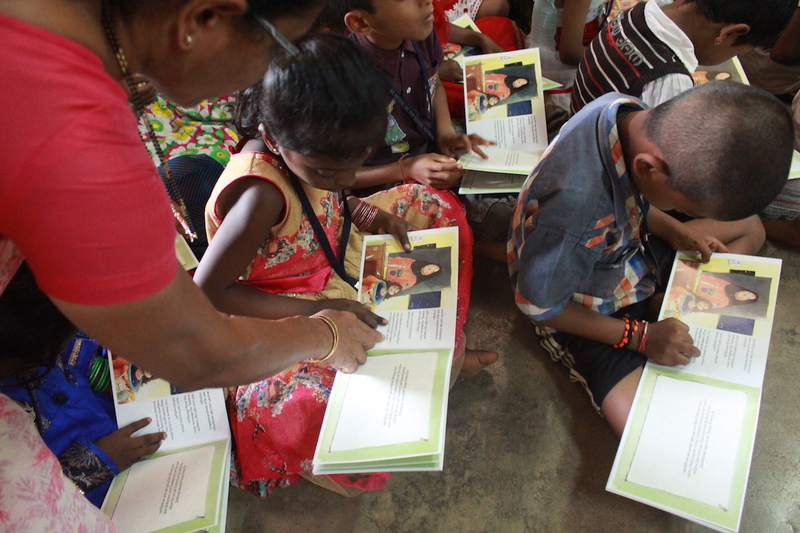
As well as the day went, I couldn’t help but go back home feeling thoughtful and a little guilty about all the preconceived notions I had been harbouring about the way children react to stories. While writing and editing children’s stories, I have always tended to base my instincts on the experiences I’ve had reading out to the children in my family. The Mangalore experiences definitely taught me a thing or two and I know I this will impact the way I deal with children’s content in the future.
What I read out to the kids was actually a pair of stories (which will eventually be two parts of the same book) - Arya in the Cockpit and Raju’s First Flight. I had written these for StoryWeaver under the theme of women who “fly”. The former follows the life of Arya as her dream to take to the skies evolves as she grows up. The latter works sort of as a primer to the second- it features Arya’s younger brother who is looking forward to take his first ever aeroplane ride on his way to meet his sister after a period of separation. This story ends with a twist - as it is revealed that his sister is the pilot of the very plane he is about to travel on.
This is where I learned my first lesson - what I fancied to be a clever twist that makes for a great story needn’t work for children with the same dramatic effect as I’d imagined. It works for children reading the book themselves, but in a classroom setting with younger kids who are being told the story, a realised I had to go a step further - be a bit more explicit, more grandiose - as it was, the text was too subtle.
These kinds of improvisations are what make a great storyteller, and I was humbled by the realisation that I was far from one. Nevertheless, I was able to catch on to this just early enough in the reading to add in some elements and ensure that the kids understood what was going on. The sister wasn’t just waiting for Raju at the end of his flight, she was in the flight, flying the plane! I may not have gotten the ‘oohs’ and ‘aahs’ I was going for, but they were amused enough - phew!
The second big lesson I learned was the presumptuousness with which I assumed a story written in English will be enjoyed just as much by non-speakers of the language. The government school was a Kannada medium one, but I was told that the students would be in in 2nd and 3rd grade and so would have a basic understanding of English. Nevertheless, ELC had organised for one of their teachers, Jayashree Guruprasad, to read out the Kannada translation (by Brinda N Rao) after I was done reading the English one.
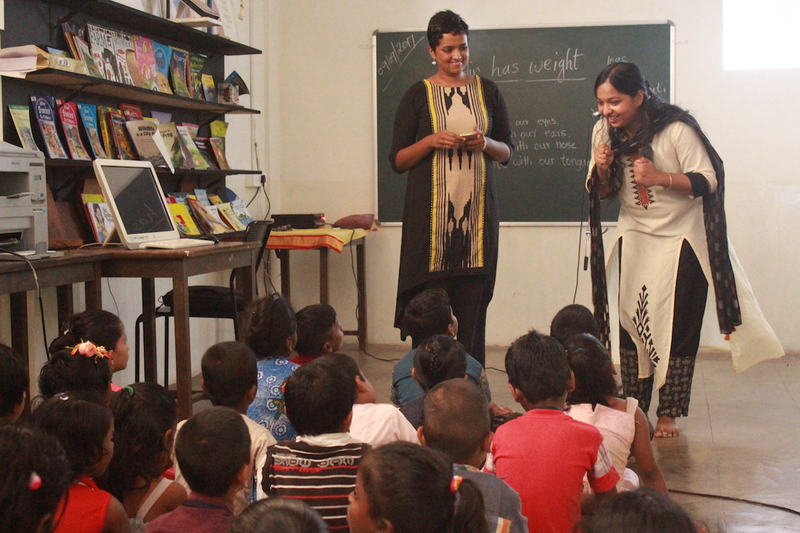
While the classroom was being set up I tried to break the ice with the kids and quickly realised that their level of English was nowhere near my understanding of ‘basic’. I suggested to Jayashree that she translate side-by-side instead of at the end and that made a big difference. The children were able to appreciate the flow of the story much better - if I had dumped that entire load of English on them, they would surely have been lost and bored, just as I would have if someone read out a whole story to me in Kannada (which I would argue I have a somewhat basic understanding of). The books given to these kids were the Kannada version. Even though it worked out, I came out with an enhanced appreciation for short sentences. There was also an opinion that the translation was somewhat too literal and the language ‘can be more colloquial, the way we speak’. I promised to pass on the feedback to Pratham Books.
My final lesson was the stark differences in lifestyles between the two groups of kids. At both venues, I started off the storytelling with talking about aeroplanes in general. These conversations with the kids before commencing the book really helped me gauge the audience. As expected, at the government school, none of the children had ever been in or even seen a plane up close - though they all were very excited by the prospect of travelling in one some day. They seemed unfamiliar with terms such as ‘cockpit’ and ‘airhostess’, so when I told the story, I avoided some words.
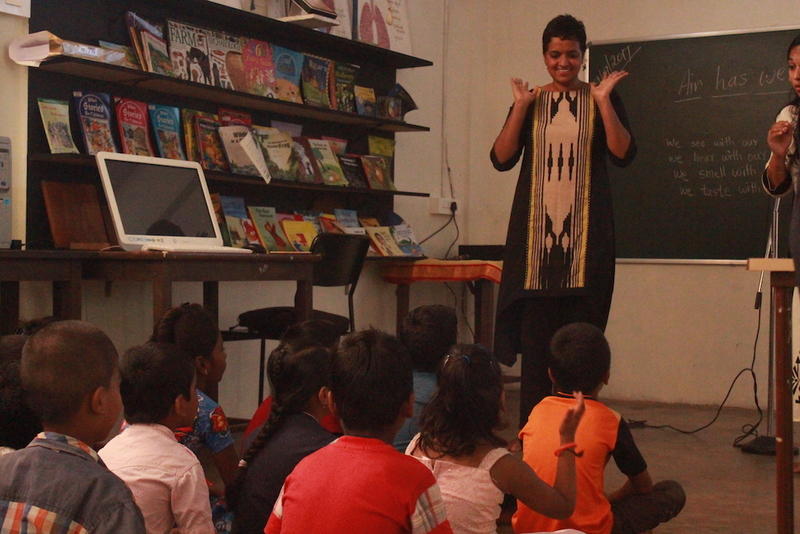
At the Montessori school, a majority of the crowd had been inside an aeroplane and were much more knowledgeable about aspects of flying that I would most definitely not have known in their age. Quite a few were familiar with concepts like the cockpit, the retractable wheels of an aircraft, etc., and many were enamoured by possibilities like the plane crashing (this came up an alarming number of times during the reading)!
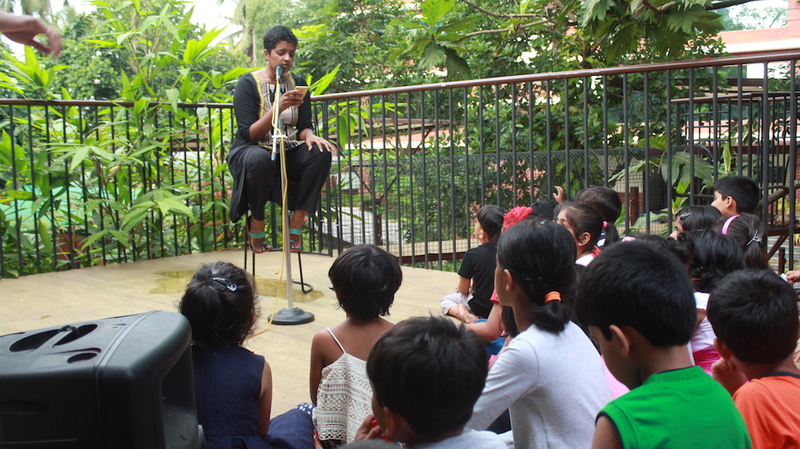
There was so much to take away from the storytelling experience and I definitely think producers of children’s content - especially ones starting out - have a LOT to gain by reading in different types of classrooms to see for themselves whether what we think works is actually working. Even if to a certain extent I knew of these good practices and my editors at StoryWeaver have emphasised it to me repeatedly, it only really hit me when I saw the proof in front of my eyes. And as a complete storytelling newbie I can confirm that this is not as scary as it sounds and if you make an effort, chances are the young kids will love you anyway.
(Photos by Girish.)
Be the first to comment.Teachers discover their inner child at StoryWeaver workshop!
Posted by Remya Padmadas on September 12, 2017Ankit Bhuptani of VIDYA, writes about a recent StoryWeaver workshop he conducted with his colleagues in Dahod, Gujarat.
I recently got an opportunity to facilitate a workshop on StoryWeaver with my colleagues Jayshree Murali and Sangeeta Gupta at Sri Sri Ravishankar Vidya Mandir, Dahod, Gujarat on 16th July 2017. Our session was was part of larger 2 day workshop on ‘Language Learning’ conducted by my organization VIDYA. VIDYA is a not-for-profit working with children, adolescents and youth in the urban slum communities of Delhi, Gurgaon, Mumbai, Bangalore and Pune. This is our 31st year having been seeded in Delhi in the home of our Founder Rashmi Misra. We have a holistic approach to education with a focus on academics, life skills and digital empowerment.
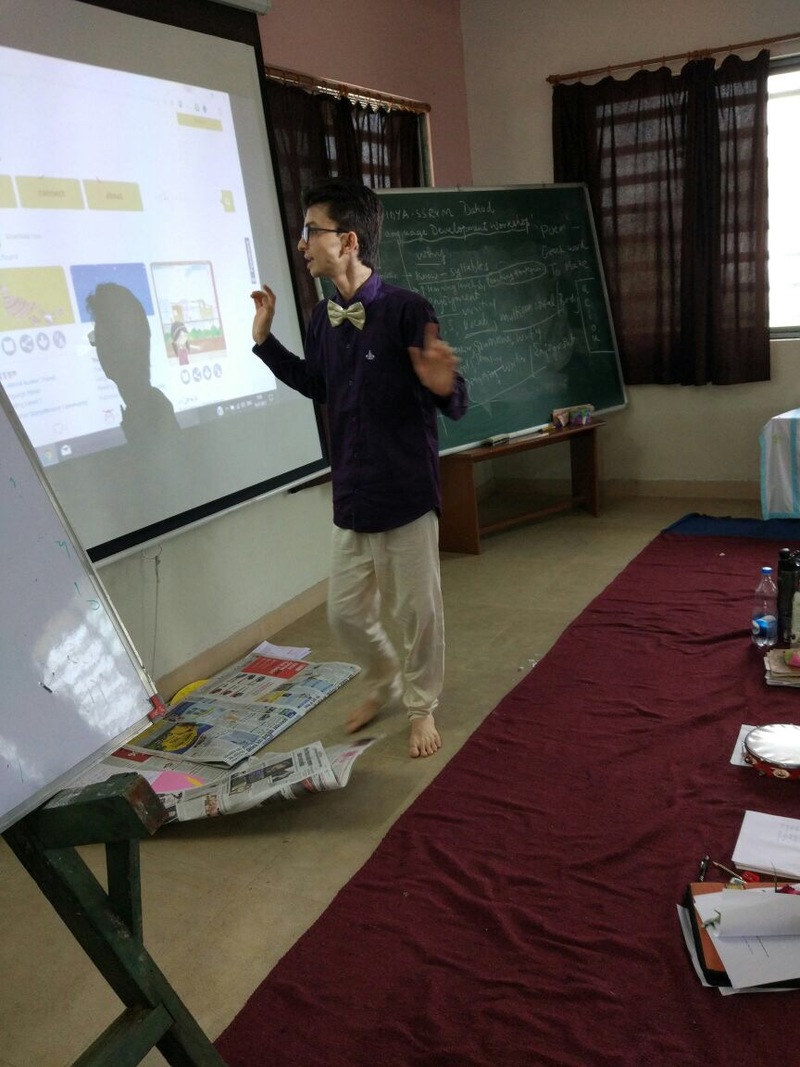
The workshop started with an introduction to the StoryWeaver platform using a short video. After this, we explored the ways to find an ideal story for the class and read a bilingual story together followed by a session on how to translate stories. This happened in small groups of 5 teachers each who logged-in on the platform and translated a story. Now was the time to create our own. But….. suddenly the power was gone! And we had to find our own ‘power'!
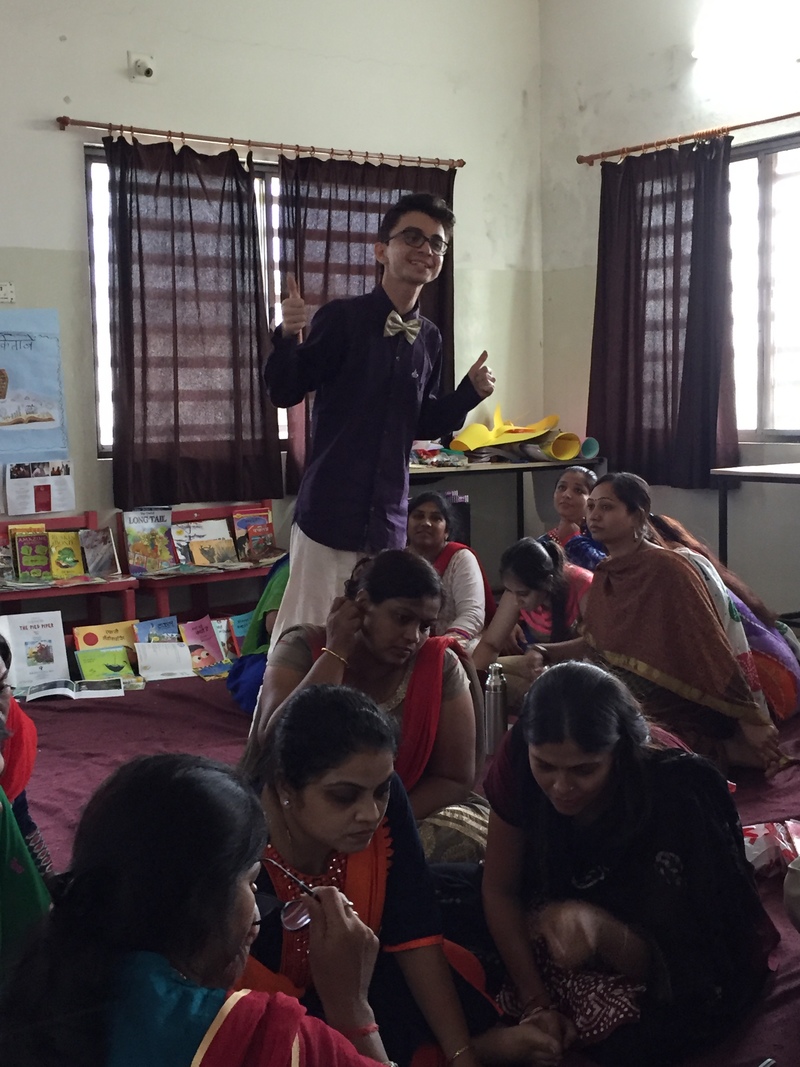
What fun it was to weave and spin a story based on the pictures which we had downloaded from very rich picture pitara of StoryWeaver. The story was about two children Pinku and Pinky who go to a jungle in search of their cat Biladi. All the teachers were immersed and the child in them surfaced.
The whole workshop not only helped teachers to understand the platform of StoryWeaver but also helped to develop important teaching skills like group building and critical thinking. The teachers felt that integrating technology in the classroom via stories was a brilliant idea.
Be the first to comment.